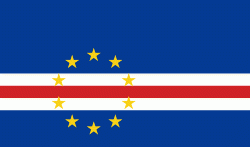Santa Maria (Santa Maria)
Santa Maria (Portuguese for Saint Mary) is a city in the southern part of the island municipality of Sal, Cape Verde. It is located on the south coast, about 16 km south of the Amílcar Cabral International Airport, and 20 km south of the island capital Espargos.
Santa Maria was founded in 1830 for the production of salt. Up to 30,000 tons of salt were shipped from Santa Maria each year. A pier was built in the area of Ponta de Vera Cruz and a small rail track was built to carry the salt to the pier. Most of the product was exported to Brazil, which was halted in 1887 when Brazil imposed a high tax on imported salt to protect its own salt production. The town went into a deep decline, only to recover in 1920 when a Portuguese investor resumed salt production. This continued until 1984. In 1935, Santa Maria was elevated from a village to a town.
In 1967, Belgian industrialists and engineers Georges Vynckier and Marguerite Massart opened Cape Verde's first resort hotel named Morabeza. After 1986, tourism became an important industry on the island, and many resorts and hotels were built in the southern and southwestern coastal areas near Santa Maria. In 2017, 48.2% of the country's available beds were on the island of Sal.
Santa Maria was founded in 1830 for the production of salt. Up to 30,000 tons of salt were shipped from Santa Maria each year. A pier was built in the area of Ponta de Vera Cruz and a small rail track was built to carry the salt to the pier. Most of the product was exported to Brazil, which was halted in 1887 when Brazil imposed a high tax on imported salt to protect its own salt production. The town went into a deep decline, only to recover in 1920 when a Portuguese investor resumed salt production. This continued until 1984. In 1935, Santa Maria was elevated from a village to a town.
In 1967, Belgian industrialists and engineers Georges Vynckier and Marguerite Massart opened Cape Verde's first resort hotel named Morabeza. After 1986, tourism became an important industry on the island, and many resorts and hotels were built in the southern and southwestern coastal areas near Santa Maria. In 2017, 48.2% of the country's available beds were on the island of Sal.
Map - Santa Maria (Santa Maria)
Map
Country - Cape_Verde
 |
 |
The Cape Verde archipelago was uninhabited until the 15th century, when Portuguese explorers discovered and colonized the islands, thus establishing the first European settlement in the tropics. Because the Cape Verde islands were located in a convenient location to play a role in the Atlantic slave trade, Cape Verde became economically prosperous during the 16th and 17th centuries, attracting merchants, privateers, and pirates. It declined economically in the 19th century after the suppression of the Atlantic slave trade, and many of its inhabitants emigrated during that period. However, Cape Verde gradually recovered economically by becoming an important commercial center and useful stopover point along major shipping routes. In 1951, Cape Verde was incorporated as an overseas department of Portugal, but its inhabitants continued to campaign for independence, which they achieved in 1975.
Currency / Language
| ISO | Currency | Symbol | Significant figures |
|---|---|---|---|
| CVE | Cape Verde escudo | Esc or $ | 2 |
| ISO | Language |
|---|---|
| PT | Portuguese language |















